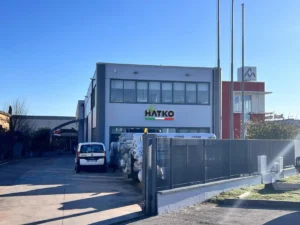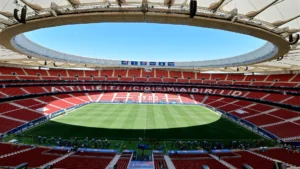Hybridgrass Maintenance
1.0 Establishment Maintenance
The grass establishment maintenance must follow the requirements as stated in data sheet 5: HG EM 01.
2.0 General Terms
The nature and scope of the services provided depend on the date of installation, the location,the subsequent weather conditions, the nature of the rootzone layer and the provision of nutrients. As a general rule, the services stated below are sufficient to handover a matured and playable HATKO HYBRIDGRASS surface.
2.1 Irrigation
The germination of the seeds and the growth of the grass require sufficient soil moisture levels in the rootzone layer. For this reason, the prerequisites for irrigation have to be established prior to the seeding. After initial saturation of the rootzone layers, the soil moisture content has to be preserved by adequately distributed irrigation. The intervals between each individual application should be increased progressively in order to facilitate the grass root depth. The irrigation water should be distributed evenly in extra fine drops.
2.2 Fertilization
The growth of the turf surface has to be stimulated by adding fertilizer. For the fertilization required until handover, it is recommended to use specific sports field fertilizers with appropriate nutrient levels considering the existing nutrient reserves in the soil and the seasonal needs of the grass.
Damages to the grass are to be prevented by the choice of the fertilizer, the determination of the application rate and the application during appropriate weather conditions. Options of choice and fertilizer data sheets are provided by on request.
2.3 Mowing
The grass has to be cut up to 12 times prior to handover. The mowing should take place at a grass leaf length of 45 mm to 60 mm. The grass must not be mown shorter than 35 mm. The mowing equipment must ensure a clean cut at even height. The equipment that is used must not leave any permanent tracks in the turf surface. Moving should not take place with humid weather.Grass clippings are to be removed from the field.
2.4 Topsoil aeration
After the second cut, the rootzone layer has to be aerated up to a depth of 100 mm using a Vertidrain machine or equivalent.
2.5 Handover
HATKO HYBRIDGRASS turf that is produced by seeding must show an even stand in terms of growth and distribution, that has to provide a projective soil coverage of 90% with plants of the chosen grass seed-mixture. The last cut prior to handover must not date back longer than three days.
2.6 Commissioning
HATKO HYBRIDGRASS that has been installed in accordance to this specification can be commissioned after handover.
3.0 Ongoing daily maintenance
The quality and the sustainability of the HATKO HYBRIDGRASS playing field depend on local conditions and the utilization, but also very much on proper and technically correct maintenance. General maintenance instructions need to be adjusted to specific maintenance programs to satisfy local conditions. Monitoring the maintenance and the recommendation of appropriate measures require a wide range of expertise.
3.1 Basic daily maintenance
The basic maintenance covers the minimum of services necessary to maintain the functionality of the playing surface. Scope and timing of these services particularly depend on the weather conditions. Long term sustainability requires regeneration maintenance in the closed season.
4.0 Preservation Maintenance
Preservation maintenance counteracts the damages occurring due to stress and usage. The scope of these services mainly depends on the extent of field utilization, but also on the vegetative growth rate.
4.1 Spring Tining
By spring-tining the thatch layer that has been formed in the surface will be opened. The old grass clippings and organic buildup will have to be removed ensuring sufficient surface aeration. Spring-tining is a standard operation executed in 14 day intervals from September to April,depending on the extent of field utilization. In case grass clippings are being collected during mowing, its frequency can be reduced.
4.2 Brushing
The brushing combination (e.g. Speedbrush or static brush device) should be applied prior to mowing and as preparation for the match, to ensure the turf quality, particularly the ball roll capacity and the optical appearance. This measure straightens up dead plant parts and fallen leaves, which thereby can be cut more effectively by the mower. Brushing also facilitates the application of sand after the topdressing in combination with an aeration of the turf surface. The frequency depends on the extent of field utilization:
- normal field utilization: 3 to 10 per year,
- medium field utilization: 1 to 2 per month,
- high field utilization weekly.
4.3 De-Tacthing
De-Thatching removes dead plant parts, which get deposited as organic residue on the ground surface. The working depth is limited to the level of thatch build up (0-15mm) and should only touch the rootzone surface, it should not reach into the soil. Depending on the weather conditions, the measure can be applied in spring and autumn or up to monthly intervals. As a follow-up treatment, it is required to collect the organic residue with the sweeper.
The frequency depends on the tendency of thatch accumulation. 1 to 4 times per year, but at least every 5 weeks.
4.4 Aeration
Aeration loosens the topsoil and creates voids to facilitate the interchange of gases, e.g. O2 and CO2, which enhances root growth and improves the biological activity of the soil.
Execution of the aeration:
- Solid- or cross-tines, diameter less than 15 mm,
- Depth 10 to 15 cm,
- 400 punches/m2.
4.5 Top Dressing
Application of sand enhances the surface structure. The assessment of the sanding volüme depends on the preceding maintenance measures. The more of the turf surface is treated, the higher the applied volume can become.
Application of the topdressing:
- Quantity per application 1 to 3 l/m2,
- Frequency 1 to 3 per year
5.0 Regeneration Maintenance
Regeneration maintenance serves for the following purposes:
- The turf is rejuvenated,
- It counteracts senescence and thereby the reduction of stress resistance,
- Preservation of the norm height and the flatness,
- Preservation of the capacity of the HATKO HYBRIDGRASS reinforcement.
The scope of these services mainly depends on the extent of field utilization and on the vegetative growth rate.
5.1 Basic Regenartion Maintenance
In order to ensure a fresh and vital turf surface, GBK special equipment is used to remove old grass and thatch at the end of the playing season to an extent that a rejuvenated turf surface can be created by over-seeding with a high quality seed mixture.
This process includes the following tasks:
- Removal of grass and thatch with the GBK Combinator fitted with hold down plate,
- Surface aeration and tilting artificial turf fibers with the GBK Renovator,
- Top-dressing with HG TD 01 or HG RSM 01,
- Subsurface aeration with Vertidrain, working depth up to 20 cm as max., with undersoil heating up to maximum 18 cm,
- Regenerative over-seeding.
5.2 Intensive Regeneration Maintenance
During the process of senescence, organic material gets deposited in the upper millimeters of the surface. A larger extent of topdressing sand sometimes leads to covering the HATKO HYBRIDGRASS artificial turf fibers. By means of precise operations, the surface is cleaned in a way that the fibers have a protrusion of 15 to 20 mm.
This process includes the following measures:
- Removal of grass and thatch with the GBK Combinator fitted with hold down plate,
- Surface aeration and tilting artificial turf fibers with the GBK Renovator,
- Top-dressing with HG TD 01 or HG RSM 01,
- Subsurface aeration with Vertidrain, working depth up to 20 cm as max., with undersoil heating up to maximum 18 cm,
- Regenerative seeding.
5.3 Plant Protection
To prevent surface damages due to fungal pathogens, suitable and approved ungicides should be applied on the very first suspicion and on every indication of symptoms. Legal requirements (sufficient know-how, approval, permit) are to be observed.Hybrid Grass Maintenance or Maintenance of hybridgrass.



